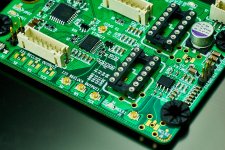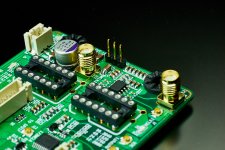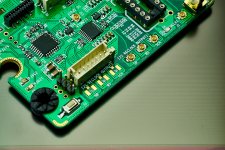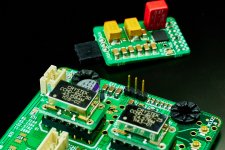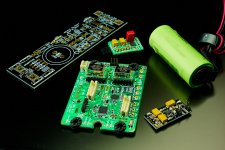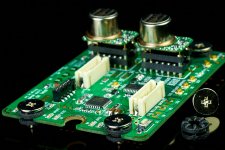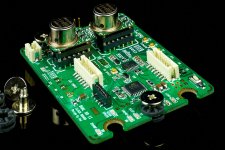Great ! I add my name to the list to extend the FIFO wish list !
Yes, yes a VII (though the v1 would suffice with TDA 1541 & AD1862 + the I2StoPCM boards I have !)
regards
Yes, yes a VII (though the v1 would suffice with TDA 1541 & AD1862 + the I2StoPCM boards I have !)
regards
PCB Layers
Just a curiosity; what is the arrangment order of those four layers?
To make it optimized to low jitter in such big frequency range, I have no choice but to use four layers PCB,..........................................................................................................
Ian
Just a curiosity; what is the arrangment order of those four layers?
Just a curiosity; what is the arrangment order of those four layers?
L1: TOP; L2: GND PLATE; L3: POWER PLATE; L4: BOTTOM
New Dual XO II clock board prototype (4)
Different from previous version, Dual XO II natively supports DACs in dual mono configuration. It has three MCLK outputs and two groups of I2S. Signals to both left and right DAC functionally are equal, but independent from each other. Reflections from one DAC will not affect the other one.
All of three MCLK outputs are compatible with u.fl socket. But two of them have reserved SMA connector footprints. Just in case more reliable and higher quality SMA coaxial cables are used in some applications.
I2S output signals, one group is in u.fl socket, the other group in PH 2.0mm connector but with reserved u.fl footprints. You can use either of them for normal stereo DAC. You will only need both of groups for dual mono DACs. Please keep in mind using same length I2S cables in this case to ensure signals arrive at same moment.
Ian
Different from previous version, Dual XO II natively supports DACs in dual mono configuration. It has three MCLK outputs and two groups of I2S. Signals to both left and right DAC functionally are equal, but independent from each other. Reflections from one DAC will not affect the other one.
All of three MCLK outputs are compatible with u.fl socket. But two of them have reserved SMA connector footprints. Just in case more reliable and higher quality SMA coaxial cables are used in some applications.
I2S output signals, one group is in u.fl socket, the other group in PH 2.0mm connector but with reserved u.fl footprints. You can use either of them for normal stereo DAC. You will only need both of groups for dual mono DACs. Please keep in mind using same length I2S cables in this case to ensure signals arrive at same moment.
Ian
Attachments
Last edited:
New Dual XO II clock board prototype (5)
@Zoef
Just like my other recent designs, to get rid of the limitation, on board LDO was removed from Dual XO II clock board. Power supply is now open to LifePO4 batteries, external LDOs, shunt regulators, third party low noise regulators and other high performance power solutions. It’s really fun trying different PSU solutions to feel the change of sound and to pick up your favorite one.
If you want to use OCXO/s, please just make sure your power supply has enough current to run the oven/s.
The input voltage is now up to what power supply you are using. But if it is possible, pick up the lower voltage for safer.
Once you are happy with your power supply, solder it directly to the clock board would be suggested. It’s better than just using a connector.
Ian
@Zoef
Just like my other recent designs, to get rid of the limitation, on board LDO was removed from Dual XO II clock board. Power supply is now open to LifePO4 batteries, external LDOs, shunt regulators, third party low noise regulators and other high performance power solutions. It’s really fun trying different PSU solutions to feel the change of sound and to pick up your favorite one.
If you want to use OCXO/s, please just make sure your power supply has enough current to run the oven/s.
The input voltage is now up to what power supply you are using. But if it is possible, pick up the lower voltage for safer.
Once you are happy with your power supply, solder it directly to the clock board would be suggested. It’s better than just using a connector.
Ian
Attachments
Last edited:
Nobody seems to jump on your announcement of a FiFo II....so, can could feed our appetite ? What to expect ? Must have or Nivce to Have ?
Best Regards
Best Regards
Nobody seems to jump on your announcement of a FiFo II....so, can could feed our appetite ? What to expect ? Must have or Nivce to Have ?
Best Regards
Hi Blitz,
Dual XO II was designed for those who are now on the waiting list. Actually I can just simply duplicate the old version without doing anything else. But I picked up the more difficult way, spending time and money to re-design/upgrade it to Dual XO II.
Just couldn’t help trying to design a perfect clock board for FIFO project, though I understand sometimes it’s really hard to achieve.
If you are happy with your Dual XO, then you don’t have to upgrade to version II, except you want to use 90/98 MHz XO, or you are running dual mono DAC, or you really care about the 2% (for me)improving on sound quality.
Regards,
Ian
Try it on ES9018 or at 384 K hz on the TDA1541 as well ? Though I have no problem of choice as I have no FIFO yet 🙂 So it will be the FIFO II!
Does the layout of the I2StoPCM has been tested at 384 ? (hopping to try some upsampling on red book materials but more than the 192 Khz with which I'm limited with my actual 22/24 clocks (Wave I/O). But not sure I can hear any difference between 192 upsampling VS 384 !
If I understood what I'v read : phase noise quality is different from a brand to another and also in relation to the Fs of the XO ! (90/98 are really better or is just to use with the ES9018 chip ?)
Does the layout of the I2StoPCM has been tested at 384 ? (hopping to try some upsampling on red book materials but more than the 192 Khz with which I'm limited with my actual 22/24 clocks (Wave I/O). But not sure I can hear any difference between 192 upsampling VS 384 !
If I understood what I'v read : phase noise quality is different from a brand to another and also in relation to the Fs of the XO ! (90/98 are really better or is just to use with the ES9018 chip ?)
New Dual XO II clock board prototype (6)
XO is based on mechanical oscillation of crystal. Anti-vibration solution is always very important to a low jitter design, though the vibration frequency could be much lower than the XO.
Rather than previous rubber ring, a new anti-vibration solution is introduced into Dual XO II, which is anti-vibration grommet. Screws and fasteners are standard parts that can be easily sourced from Digikey or Mouser. They can also be picked up from used CDROM/DVDROM drivers. No longer need to struggle with finding out suitable and durable rubber rings.
New solution is compatible with Dual XO screw positions and can use both four points and three points support.
Ian
XO is based on mechanical oscillation of crystal. Anti-vibration solution is always very important to a low jitter design, though the vibration frequency could be much lower than the XO.
Rather than previous rubber ring, a new anti-vibration solution is introduced into Dual XO II, which is anti-vibration grommet. Screws and fasteners are standard parts that can be easily sourced from Digikey or Mouser. They can also be picked up from used CDROM/DVDROM drivers. No longer need to struggle with finding out suitable and durable rubber rings.
New solution is compatible with Dual XO screw positions and can use both four points and three points support.
Ian
Attachments
Looking great Ian.
Mechanical vibrations are detrimental, for sure. I'll also be using a few other means to reduce vibrations further, such as those Audio footers.
How are those Pulsar clocks sounding?
Ryan
BlackPod High Performance Audio Footers
Mechanical vibrations are detrimental, for sure. I'll also be using a few other means to reduce vibrations further, such as those Audio footers.
How are those Pulsar clocks sounding?
Ryan
BlackPod High Performance Audio Footers
Last edited:
How are those Pulsar clocks sounding?
ryanj
you will find more information here
http://www.diyaudio.com/forums/vend...clock-ultra-low-noise-ocxo-3.html#post4086431
http://www.diyaudio.com/forums/vend...clock-ultra-low-noise-ocxo-4.html#post4208845
Thanks clsidxxl,
Yes I've read those threads/posts, sounds like they made a substantial improvement in your setup, what other clocks have you tried besides the crystek 957?
I'm looking forward to hearing Ians impressions.
Hello Ian,
About the FIFO V2 : could it be hard for you to add :
- The possibility to buffer an already splitted Data signal as well (staying of course on more simple I2S possibility for most of people) ? I.e. : allow to putt the I2StoPCM board behind the FIFO to allow the FIFO to be closer to the DAC chip and buffering the already good jitter rejection of the simultaneous mode ? (and fight even more against the jitter by making more short the distance between the fifo chip and the dac chip: short line = no added jitter because length with the I2StoPCM pcb and uf-l cables when putted in front of the FIFO like it is made today)
- To allow via the FGPA the non used bits of the 32 bits chip to have a no lost digital volume with multibit dacs (which are all bellow 24 bits) ? A la Soren in him DAM 1021 DAC : there are connectors to set up the digital volume with a simple plastic pot !
When I see elswhere all those avc traffos with big length of copper, I wake up abruptly in the middle of the night, crying for the global warming because the long length of copper like for my hard winned money !
Stacking or short wires is one of my concern !
Bad ideas from me (the second is from an OZ's friend) ?
About the FIFO V2 : could it be hard for you to add :
- The possibility to buffer an already splitted Data signal as well (staying of course on more simple I2S possibility for most of people) ? I.e. : allow to putt the I2StoPCM board behind the FIFO to allow the FIFO to be closer to the DAC chip and buffering the already good jitter rejection of the simultaneous mode ? (and fight even more against the jitter by making more short the distance between the fifo chip and the dac chip: short line = no added jitter because length with the I2StoPCM pcb and uf-l cables when putted in front of the FIFO like it is made today)
- To allow via the FGPA the non used bits of the 32 bits chip to have a no lost digital volume with multibit dacs (which are all bellow 24 bits) ? A la Soren in him DAM 1021 DAC : there are connectors to set up the digital volume with a simple plastic pot !
When I see elswhere all those avc traffos with big length of copper, I wake up abruptly in the middle of the night, crying for the global warming because the long length of copper like for my hard winned money !
Stacking or short wires is one of my concern !
Bad ideas from me (the second is from an OZ's friend) ?
Last edited:
Hi, All,
I'm posting here for the first time, though I've been reading diyaudio forum already for a number of years. And since a couple of years ago I started reading Ian's fifo thread with great interest. So last year finally decided to write myself into the waiting list and now I'm eagerly waiting for the next GB. Hope it will happen soon! In the meantime, I keep on reading this forum educating myself and planning on how I will setup the fifo in my system. Since I'm a beginner, I'd like to do things sequencially improving the system slowly and learning at the same time. Recently since Ian announced Dual XO II, I've seen some people making suggestions on what they would like to see improved. In this spirit I would also like to share what I would prefer to see addressed to make it easier for someone like me, i.e. a starter. These are:
- integrate backdoor kit (so no soldering would be required);
- integrate separate power supply into dual xo board, so when used with an isolator, no un-soldering is required and one can go back and forth to the system with or without an isolator;
- provide separate power supply input on spdif board. This is to enable a solution when system is configured as spdif fifo with simultaneous i2s output and an isolator in between of fifo and dual xo board.
This is based on my reading of this thread; forgive me if I misundertood something (in the end, I've not actually hold these boards in my hands).
Thanks!
I'm posting here for the first time, though I've been reading diyaudio forum already for a number of years. And since a couple of years ago I started reading Ian's fifo thread with great interest. So last year finally decided to write myself into the waiting list and now I'm eagerly waiting for the next GB. Hope it will happen soon! In the meantime, I keep on reading this forum educating myself and planning on how I will setup the fifo in my system. Since I'm a beginner, I'd like to do things sequencially improving the system slowly and learning at the same time. Recently since Ian announced Dual XO II, I've seen some people making suggestions on what they would like to see improved. In this spirit I would also like to share what I would prefer to see addressed to make it easier for someone like me, i.e. a starter. These are:
- integrate backdoor kit (so no soldering would be required);
- integrate separate power supply into dual xo board, so when used with an isolator, no un-soldering is required and one can go back and forth to the system with or without an isolator;
- provide separate power supply input on spdif board. This is to enable a solution when system is configured as spdif fifo with simultaneous i2s output and an isolator in between of fifo and dual xo board.
This is based on my reading of this thread; forgive me if I misundertood something (in the end, I've not actually hold these boards in my hands).
Thanks!
Twisted Pears 'Hermes' and Miero's BBB-'botic' integration with Ian's Fifo
Hi everybody!
Any thoughts about the TP/BBB cape solutions in combination with our beloved Fifo/clocks?
Ed
Hi everybody!
Any thoughts about the TP/BBB cape solutions in combination with our beloved Fifo/clocks?
Ed
Last edited:
- Home
- Source & Line
- Digital Line Level
- Asynchronous I2S FIFO project, an ultimate weapon to fight the jitter
